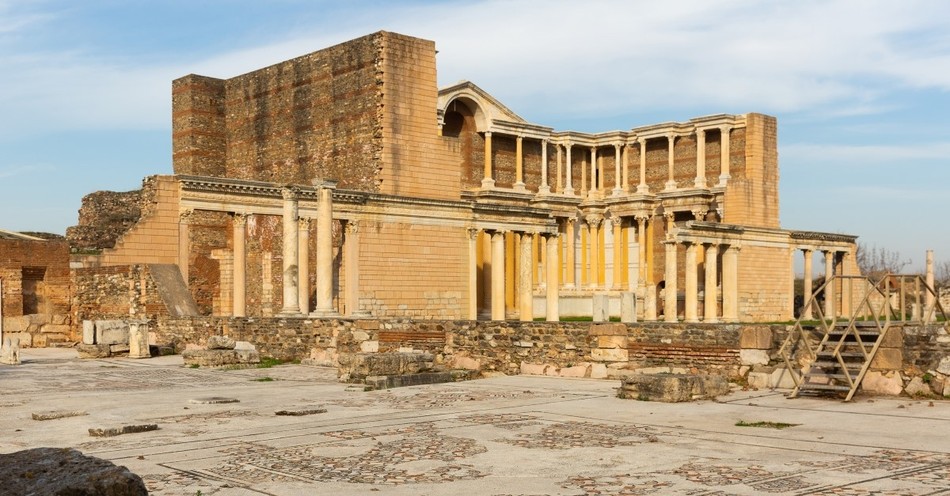In one of His famous encounters with the religious leaders of His day, Jesus declared that the Pharisees and scribes had become like“whitewashed tombs which on the outside appear beautiful, but inside are full of dead men’s bones and all uncleanness” (Matthew 23:27-28). These were harsh words, but if anyone had the insight and authority to make such a judgment, it was the Son of God. Sadly, Christ would make a similar assessment of the church at Sardis in the book of Revelation.
Jesus Christ, whose “eyes were like flames of fire” (Revelation 2:18), had seen through Sardis’ outward appearance, pronouncing the church dead inside.
But how did this once effective church that looked good on the outside become such a lifeless façade of professional but spiritually dead Christians? What lessons can Christians in all ages take from Christ’s sobering assessment of the church at Sardis?
Where Does Revelation Mention the Church at Sardis?
Most Christians are familiar with the themes and images of Revelation, which focuses on the glorious Second Coming of Jesus Christ and the events surrounding the last days. But while the bulk of Revelation details events that are still to come, Revelation’s early chapters speak to specific issues present in several first-century churches in Asia Minor (modern-day Turkey). Readers of the book Revelation should remember, however, that Christ’s instructions to these seven churches of Asia Minor are not limited to just these churches. In the same way, Revelation should not be studied as a book just for the church of the last days.
In fact, John writes in the prologue of Revelation that “blessed is he who reads and those who hear the words of the prophecy, and heed the things which are written in it; for the time is near” (Revelation 1:3),
The prophecies in Revelation, along with Christ’s instructions to the seven churches of Asia Minor, are intended to encourage and equip Christians in all ages as they anticipate and prepare for the long-awaited return of Jesus Christ.
Christ’s letter to the church at Sardis (Revelation 3:1-6), while targeted to a specific church, also warns all spiritually dead Christians. On the other hand, faithful believers can take hope in knowing that their salvation is eternally secure in Jesus Christ.
Where Was the Church at Sardis Located?
Of the seven churches mentioned in Revelation, the church at Sardis was located in one of the oldest cities in Asia Minor. Founded in roughly 1200 BC, Sardis was once the capital of the wealthy Lydian Kingdom. It had been strategically built atop a lofty plateau above the Hermus River Valley, making the city nearly impervious to attack from below. Sitting atop steep, fortified cliffs, with access to gold and other natural resources from the Hermus Valley and Pactolus rivers, the citizens of Sardis had enjoyed relative security and prosperity for centuries.
Unfortunately, overconfidence and complacency led to Sardis’ downfall on multiple occasions. Feeling secure in their high position, the Lydian garrison at Sardis neglected to guard the cliffs at the rear of the city, believing them too steep for any invading army to climb. Unfortunately for the Lydians, Persian forces did just that in 359 BC, taking the city shortly after.
Ironically, the Persians had not learned from their predecessors. They made the same mistake in 218 BC when Antiochus III of Syria used a talented mountain climber from Crete to scale the undefended cliffs, enter the city, and open the gates for the attacking army.
Though the city was defeated and rebuilt several times by invading armies, Sardis’ enviable defensive position, natural resources, and proximity to important trade routes made it a valuable city to the Persian, Greek, and Roman Empires.
Located roughly thirty miles southeast of Thyatira, Sardis came under Roman control in 133 BC and remained prosperous through most of the Roman Empire period. Even after a devastating earthquake destroyed the city in AD 17, the Romans were able to rebuild Sardis and restore its economy.
However, by the time John wrote to the church of Sardis at the end of the first century, the city had become a shell of its former shelf. Its reputation as a thriving center of commerce remained intact; but the heart of the city, like its church, was already declining.
What Mistake Did the Church at Sardis Make?
Like several churches mentioned in Revelation, we know very little about the founding of the church at Sardis. The most likely scenario is that Christianity took root in Sardis as an outreach of Paul’s ministry in Ephesus.
But what caused the church at Sardis to fall so far as to be pronounced dead by Jesus Christ? In Revelation chapter 3, Jesus instructs John to write to Sardis with these harsh but honest words, “I know your deeds, that you have a name that you are alive, and yet you are dead” (Revelation 3:1).
Like its city and the hill it stood on, the church at Sardis may have seemed strong on the outside. It had a good name and good reputation. It was probably respected as a once-thriving church in the region. On the inside, however, the light of the church had been snuffed out in a way that only Christ could identify.
What is more troubling is that the believers of Sardis may not have even realized it. Like the garrison of Sardis under the Lydians and Persians, the believers of Sardis may have thought they were secure. In reality, the Holy Spirit had long since departed their church.
Sadly, those who can no longer recognize the sinful state of their own heart or when the spirit has left them are in danger of also being pronounced spiritually dead.
On the outside, the church of Sardis may have looked fine. Their appearance, however, had not fooled Christ. He knew the inward state of their heart. He also knew those who genuinely sought after Him as compared to those just going through the motions.
This was a church in name only, whose members had grown overconfident and complacent in their prosperity, security, and good works apart from Christ.
Sadly, many within the church’s walls are also convinced they are safe and secure. They may even do the right things. In reality, they are playing church and living a lie.
Thankfully, a handful of true believers at Sardis had not “soiled their garments” or lost their light. Their character had been kept pure. Their hearts had kept hungering and thirsting for God’s goodness and grace. To these, Christ promised, “they will walk with Me in white, for they are worthy. The one who overcomes will be clothed the same way, in white garments; and I will not erase his name from the book of life, and I will confess his name before My Father and before His angels” (Revelation 3:5).
These believers could find hope in the assurance of their salvation in Christ and know that their names were eternally sealed in the book of life.
To the rest, however, Christ’s call to repentance and promise of judgment could not be more urgent:
“Be constantly alert, and strengthen the things that remain, which were about to die; for I have not found your deeds completed in the sight of My God. So remember what you have received and heard and keep it, and repent. Then if you are not alert, I will come like a thief, and you will not know at what hour I will come to you.” (Revelation 3:2-3)
What Can We Learn from the Church at Sardis?
Unlike the other letters written to the seven churches of Revelation, Christ’s letter to the church at Sardi’s jumps straight into Christ’s concern for the church. No commendation, just a warning. The situation in Sardis was dire. In His grace, however, Christ offered the believers of Sardis one final chance to wake up, repent, and become alive in Christ again.
The warnings to heed and lessons to be learned are directed to those with “ears to hear what the Spirit says to the churches” (Revelation 3:6).
From the words of Christ’s letter to the church at Sardis, several truths become instantly applicable for believers in all ages:
“Wake Up”
Like a driver asleep at the wheel of a moving car, a complacent or careless Christian is destined for a crash. In fact, throughout Scripture, sleepiness or drowsiness is often used to describe unprepared or unfocused believers. They may have eyes, but they do not see. They may have ears, but they do not ear. These Christians are spiritually asleep and just going through the motions.
Furthermore, as the defenders of Sardis had left the cliffs of their city unguarded, Christians who ignore God’s warnings will tolerate sin and even allow personal weaknesses to be exploited by a very real, very persistent enemy (1 Peter 5:8).
The call from Christ, however, is clear: wake up and always be alert.
“Strengthen the Things that Remain”
Although Christ’s assessment of the church at Sardis was that it was dead in its sins, God alone has the power to raise the dead and bring dry bones to life (Ezekiel 37:1-14). God is not beyond saving a sick or dying church, nor is He beyond reviving the life of a fading believer. His message to the church at Sardis is the same as to the struggling church or individual believer today. Find what is good, hold on to the dying embers, and look to God to rekindle the flame before it goes out entirely.
“Remember the Things You’ve Received and Heard”
In many instances, an individual believer’s light, like a church’s light, starts fading when it forgets God’s truth and good things. The believers in Sardis needed to return to the gospel and the apostles’ teachings above their own wisdom, rituals, or routines.
Furthermore, to avoid getting to this place, Christ urges all believers to remember what they have received and been taught from the Word of God. As the Psalmist writes, the righteous man will “delight is in the Law of the Lord, and on His Law he meditates day and night. He will be like a tree planted by streams of water, which yields its fruit in its season, and its leaf does not wither; and in whatever he does, he prospers” (Psalms 1:2-3).
“Keep and Obey God’s Word”
Of course, true revival does not come by merely hearing. One must also put into practice the things one has heard and choose to obey God’s Word. Therefore, the believers of Sardis were challenged to know the truth and act upon it (James 1:22-25). It’s not enough to have biblical knowledge if correct belief does not lead to correct living.
“Repent”
For the church of Sardis to come alive again, its members had o confess and turn from their sin. No church or individual believer can ever hope to experience genuine revival without genuine repentance. Furthermore, Christ’s warning of impending judgment to Sardis should remind believers in any period: God’s promises are true. That includes His promise of forgiveness and grace. It includes His promise to judge those who reject Him and refuse to turn from their sinful ways.
Photo Credit: Getty Images/JackF

This article is part of our larger End Times Resource Library. Learn more about the rapture, the anti-christ, bible prophecy and the tribulation with articles that explain Biblical truths. You do not need to fear or worry about the future!
The Second Coming of Jesus
Who Are the 144,000 in Revelation?
Who Are Gog and Magog in the Bible?
What Is the Apollyon?
Is the Apocalypse Mentioned in the Bible?
Signs of the End Times and the Rapture


.jpg)
